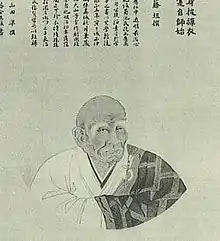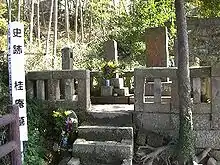- For the Japanese era, see Keian (1648-1652).
Keian Genju | |
|---|---|
| 桂庵 玄樹 | |
 Keian Genju at Kagoshima | |
| Born | 1427 |
| Died | June 28, 1508 (aged 80–81) Kagoshima, Satsuma Province, Japan |
Keian Genju (桂庵 玄樹, 1427 – June 28, 1508) was a Rinzai school Buddhist priest and Confucian scholar in late Muromachi period Japan, who is noted for forming the Satsunan school of Japanese Neo-Confucianism.[1][2] who studied classics under Ishō at Nanzen-ji.[3]
Biography
Keian was born in Akamagaseki, Nagato Province (present day Shimonoseki, Yamaguchi). When he was nine years old, he became a monk and went to study at Kyoto's Nanzen-ji. Afterwards, he went to Manju-ji Temple in Bungo Province for further study, and was invited by Ōuchi Yoshitaka to become the chief priest of Eifuku-ji in Nagato Province, his hometown. Keian accompanied the 1466 mission to the Ming court in China. In Beijing, he was favored by the Chenghua Emperor.[4] He studied in Suzhou and other places, where he developed an interest in Neo-Confucianism. Keian delayed his return to Japan until 1475.,[4] but took refuge in Iwami Province to escape the ravages of the Onin War. In 1478, he was invited by Shimazu Tadamasa to become chief priest of Shōkō-ji in Ōsumi Province and Ryūgen-ji in Hyūga Province. Furthermore, he was invited by Shimazu Tadayoshi to lecture on Neo-Confucianism at Keijū-in in Satsuma Province.[5]
In 1481, Keian published his translation of Zhu Xi's Collective Commentaries on the Great Learning, the first such translation of that work into Japanese.[6] This made him famous as the founder of the Satsunan school of Neo-Confucianism.[7] He later went on to become chief priest of Kennin-ji and Nanzen-ji in Kyoto. At the age of 76, he retired to Toki-an (the location of his grave) in Satsuma and died at the age of 82.[5]
Grave of Keian

Keian's grave is located in the cemetery of Keijū-in in Ishikichō, neighborhood of Kagoshima City, at the foot of a mountain to the west of the city. The grave was constructed by his disciples on the 25th anniversary of his death, but a tombstone was not erected until 1722. It was designated as a National Historic Site in 1936.[8] Currently, the whole area is maintained as Keian Park.[5]
The grave is about 4.8 kilometers north of JR Kyushu Kagoshima-Chūō Station.
See also
Notes
- ↑ Ponsonby-Fane, Richard. (1962). Sovereign and Subject, p. 242-246.
- ↑ Iwao, Seiichi et al. (2002). Dictionnaire historique du Japon (Vol. I), p. 1490.
- ↑ Ponsonby-Fane, p. 243.
- 1 2 Ponsonby-Fane, p. 244.
- 1 2 3 Isomura, Yukio; Sakai, Hideya (2012). (国指定史跡事典) National Historic Site Encyclopedia. 学生社. ISBN 4311750404.(in Japanese)
- ↑ Xinzhong Yao. (2005). An Introduction to Confucianism, p. 127.
- ↑ Iwao, Seiichi et al. (2002). Dictionnaire historique du Japon (Vol. II), p. 2376.
- ↑ "桂菴墓" (in Japanese). Agency for Cultural Affairs. Retrieved 20 August 2021.
References
- Iwao, Seiichi, Teizō Iyanaga, Susumu Ishii, Shōichirō Yoshida et al. (2002). Dictionnaire historique du Japon (Vol. I), (Vol. II). Paris: Maisonneuve & Larose. ISBN 978-2-7068-1632-1; OCLC 51096469
- Ponsonby-Fane, Richard Arthur Brabazon. (1962). Sovereign and Subject. Kyoto: Ponsonby Memorial Society. OCLC 1014075
- Xinzhong Yao. (2005). An Introduction to Confucianism. Cambridge: Cambridge University Press. ISBN 978-0-521-64312-2; ISBN 978-0-521-64430-3; OCLC 255153845